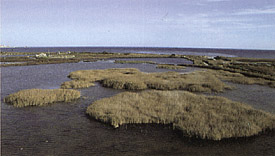The Santa Pola Salt Pans
| The current form is the result of the carrying-down of sediment by the Segura and Vinalopo rivers which, in conjunction with marine currents, produced an offshore bank, turning the area into a coastal lagoon. Nowadays, as well as the usage for salt extraction, there are fresh-water pools, a region of beaches and dunes and land used for agriculture. The installation at the end of the 19th century of plant to exploit the extraction of salt has permitted this wetland to continue to exist. Not only is it protected as a Natural Park but it is also included in the list of Wetland areas of Europe and North Africa as part of the "Sea International" project (1965) and ratified in the International Convention on Wetlands and Aquatic Birds known as RAMSAR (Iran 1971) for the protection of wetlands of international importance and especially as habitats for birds. Likewise it has been declared a "Region of Special Importance for Birds" as laid down in Directive 79/409 of the European Union. The diversity of fauna, especially bird-life, is what makes this small area so significant. A factor fundamental to the maintenance of the great variety of species to be found there is the permanent circulation of sea water. This carries in large quantities of organisms which proliferate in the lagoons of the Salt Pans and form the food for the fish and the aquatic birds which live on them. Among the types of fish which are noteworthy are the Fartet (Aphinius Iberus or Spanish toothcarp) which is a native of the Iberian mediterranean and North African coasts; and, for their great numbers, various species of mullet. As for the bird-life, the large numbers of broad-billed birds are noteworthy, this being one of the few sites on the Iberian peninsular where there is a permanent flock (up to 3,500) of flamingos (Phoenicopterus ruber). It is also the only site in the region where the Stork (Himantopus himantopus) over-winters. The duck-like birds which are most abundant are: the Coloured Duck (Netta rutina), the Shoveller Duck (Anas clypeata) and the Coot (Fulica atra). In lesser numbers are the Pintail (Anas platyrhynchos), Common Ring-necked Duck (Aytha ferina) and the Marbled Duck (Marmaronetta angustirostris). The most common raptors are the Lake Eaglet (Circus aeroginosus) and the Osprey or Fish Eagle (Pandion haliaetus). |
The Sierra and Cape of Santa Pola
| This natural environment is noteworthy not only for providing a spectacular landscape, recently chosen as a logo to represent the locality, but also for its plant and animal life. The vegetation, adapted to the climatic and soil conditions, consists of trees in the form of pine groves (Pinas halepensis) which are found in the lower, sunnier areas. In the higher scrubland, protected in the gullies are to be found the dwarf fan palm (Chamaerops humilis), blackthorn (Rhamnus lycioides), the mastic tree (Pistacia lentiscus), wild olive (Withania frutescens), bay Close to the sea, on the slopes, we find the 'hinojo marino' (Rock Samphire - Chrithmum maritimum), 'colecha' (Sea Lavender - Limonium spp.), 'siempreviva marina' (Everlasting Plant - Helichrsyum decumbens), 'salado negro' (literally salty black - Frankenia webii), 'ull de bou' (Asteriscus maritimus), 'cambron' (Matrimony Vine - Lycium intricatum), 'clavel silvestre' (Wood Carnation - Dianthus malacitanas), etc. On the higher ground the wild thymes predominate, among which we can cite the 'tomillo vulgar' (Common thyme - Thymus vulgaris aestivus), the 'rabo de gato' (Cat's Tail - Sideritis leficantha), 'albaida fina' (Anthyliis terniflora), 'canamillo' (Anthyllis cytisoides) and the 'heliantemo de hoja de lavandula' (Helianthemus or Rock Rose - Helianthemum lavendulaefolium). As for the fauna, the bird life is very diverse and abundant; the mammals are best represented by the hares (Lepus europaeus), rabbits (Orycytolagus cuniculus), hedgehogs (Erniaceous algirus) and foxes (Vulpes vulpes). This region, together with the 'Salinas', forms an area of natural beauty for the enjoyment and recreation of the community as well as an important instrument for environmental conservation. |
 With an area of 2,470 hectares and situated at the west/southwest of the town, he Salt Pans (Salinas) form part of a triangle known as the South Alicante 'trowel' together with the lakes of Hondo, Torrevieja and La Mata.
With an area of 2,470 hectares and situated at the west/southwest of the town, he Salt Pans (Salinas) form part of a triangle known as the South Alicante 'trowel' together with the lakes of Hondo, Torrevieja and La Mata. Circling the town to the east and north-east rise the slopes of the mountain (Sierra) and cape (Cabo) of Santa Pola, the latter forming the northern end of the bay of Santa Pola. The steep cape was originally the sea bed which appeared when the sea level fell in the geological past. The Sierra, which was formed similarly, is cut through by a large number of gullies which carry rainwater flow to discharge
Circling the town to the east and north-east rise the slopes of the mountain (Sierra) and cape (Cabo) of Santa Pola, the latter forming the northern end of the bay of Santa Pola. The steep cape was originally the sea bed which appeared when the sea level fell in the geological past. The Sierra, which was formed similarly, is cut through by a large number of gullies which carry rainwater flow to discharge